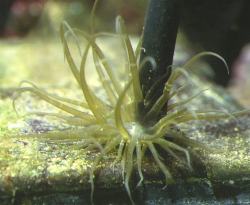 We all know how difficult most anemones are to maintain, so what a relief to find a species not only easy to keep but quick to multiply.....WRONG! Aiptasia anemones are the proverbial wolves in sheep's clothing. They have a prodigious sting capable of killing (as a prelude to eating) small fish and even larger fish can sustain a nasty injury if contact is made. Reef tanks suffer particularly badly, for as the anemones spread amongst the polyps, corals, clams and other anemones they tend to sting everything they touch.
We all know how difficult most anemones are to maintain, so what a relief to find a species not only easy to keep but quick to multiply.....WRONG! Aiptasia anemones are the proverbial wolves in sheep's clothing. They have a prodigious sting capable of killing (as a prelude to eating) small fish and even larger fish can sustain a nasty injury if contact is made. Reef tanks suffer particularly badly, for as the anemones spread amongst the polyps, corals, clams and other anemones they tend to sting everything they touch.
The fish-only aquarist luckily find themselves in a relatively fortunate position as even these resistant anemones are no match for a treatment of copper-based medication. Other alternatives are to introduce fish species that look upon these anemones as tasty snacks; for example, larger angelfish and most butterflyfish. The easiest option is to remove the offending pieces of rock in which colonies are established and scrub them under a hot water tap!
The reef hobbyist is not quite so lucky, as none of the above options are open, realistically speaking. Many alternatives have been tried, all with varying degrees of success, and it would be wise to attempt the less drastic first.
The biological solution is to introduce an anemone-consuming fish or invertebrate. Unfortunately, these tend to be too indiscriminate with other livestock and will happily nibble the very corals you are trying to save!
The second, and perhaps the most effective option is to use a syringe and inject the offending anemone with a lethal dose of calcium additive. This has the added advantage of being safe should any of the solution escape into the surrounding water. In fact, almost any additive could be used if the first proves ineffective.
Other methods have been suggested, such as lodging a copper wire in the body of the anemone until it has demised through copper poisoning (unfortunately, this might prove very risky as all invertebrates are sensitive to copper toxicity).
The third alternative is to fill a syringe with very hot water and squirt it at the base of the anemone. I'm assured that it does work, although it didn't when I tried it! It could also prove harmful to invertebrates in the immediate vicinity.
Two strategies guaranteed to make most of us wince, but proven effective nonetheless, involve the use of a sharpened screwdriver! The first method requires that the instrument is pushed into the anemone's hiding hole and the animal ground to pulp! The second is similar but the screwdriver is heated to red-hot and the same procedure carried out! It is recommended that both are carried out in a separate bucket or just above the surface of the tank water. Take the utmost care if either of these procedures are attempted.
When all is said and done, it is best to purchase only those rocks that are Aiptasia-free in the first place, from tanks noticeable by their absence!
© Nick Dakin. May not be reproduced in part, or whole, without permission.

